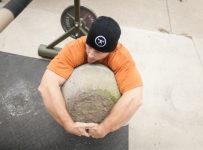From Charles Poliquin
Gain strength and muscle by training for optimal testosterone response. Summer is coming and it’s the perfect time to focus on maximizing testosterone levels since this most potent muscle-building hormone correlates with lean mass and lower body fat.
For example, a 2011 study in professional rugby players from New Zealand found that over a weight training cycle, muscle, strength, and power gains were greater when post-workout testosterone (T) levels are highest. Not only that, T response varied individually based on the type of protocol trained (hypertrophy vs. strength, for example).
Wondering what you can do to increase T levels?
First, understand the relationship between body composition and testosterone based on the rugby study. Second, shape your diet for optimal T response, while helping to clear cortisol post-workout.
The rugby study first identified which training protocol produced the greatest post-workout T response in each player (squats, seated row, leg press, and bench press were trained). Then, for 3 weeks the players did that protocol, and for the following 3 weeks they did the protocol that produced the smallest T response. The protocols tested were 4 sets of 10 at 70 percent of 1RM; 3 X 5 at 85 percent; 5 X 15 at 55 percent; or 3 X 5 at 40 percent.
Results showed that optimal T response varied in the athletes: Two had the largest T response to performing 3 X 5 at 40 percent—a surprisingly light load and low volume. The majority of the players had the greatest T response to 4 sets of 10 at 70 percent. Strength and muscle mass gains increased significantly when the players trained for maximal anabolic T response. They lost both strength and muscle mass when they did the protocol that minimized T.
This is compelling evidence that if you train to maximize anabolic response, you’ll get rapid, dramatic body composition results. If you don’t, you might gain fat and lose muscle. Researchers suggest that trainees should retest hormone response at the end of every training cycle—every 3 weeks would be ideal—and modify workouts to avoid plateaus.
In addition, something as simple as doing excessive cardio work in addition to weight training could significantly stunt your fat loss progress for summer if it ended up lowering T and raising cortisol, the hormone that counteracts T and compromises muscle gain and fat loss.
There are two takeaway points from this study: First, individuals with a “low” T-response threshold may have a greater anabolic response to a low-load, explosive training protocol, such as 85-95 percent 1 RM Olympic lifts of power squats for 5 sets of 3. Alternately, for those that require a large volume of exercise to elicit a T response, hypertrophy-style will be more effective.
Second, sleep practices and diet will dramatically affect the body’s ability to produce T when you want it. Not eating enough healthy fat, eating sugar or high-carb foods, not having adequate zinc, magnesium, or vitamin D, or not sleeping well will all compromise T and body composition. Read more in the article Five Simple Ways to Raise Testosterone Levels for Better Body Composition and Optimal Health.
References
Beaven, C., Cook, C., Gill, N. Significant Strength Gains Observed in Rugby Players After Specific Resistance Exercise Protocols Based on Individual Salivary Testosterone Responses. Journal of Strength and Conditioning Research. 2008. 22(2), 419-425.
Beaven, C., Gill, N., Cook, C. Salivary Testosterone and Cortisol Responses Following Four Resistance Training Protocols in Professional Rugby Players. Journal of Strength and Conditioning Research. 2008. 22, 426-432.
Source: http://www.charlespoliquin.com/Blog/…-Response.aspx






